1996 CADILLAC FLEETWOOD key
[x] Cancel search: keyPage 115 of 306

Downloaded from www.Manualslib.com manuals search engine I
Brake System Warning Light
Your Cadillac’s hydraulic brake system is divided into
two parts. If one part isn’t worlung, the other part can
still work and stop you. For good braking, though, you
need both parts working well.
If the warning light comes on, there could be a brake
problem. Have your brake system inspected right away.
BRAKE
This light should come on
when you turn the ignition
key to START. If
it doesn’t
come on then, have it fixed
so it will be ready to warn
you if there’s a problem.
If the light comes on while you are driving, pull off the
road and stop carefully. You may notice that the pedal is
harder to push. Or, the pedal may go closer to
the floor.
It may take longer to stop. If the light is still on, have the
vehicle towed for service. (See “Towing Your Vehicle”
in the Index.)
Your brake system may not be working properly
if the brake system warning light is on. Driving
with the brake system warning light on can lead
to
an accident. If the light is still on after you’ve
pulled off the road and stopped carefully, have
the vehicle towed for service.
When the ignition is on, the brake system warning light
will also come on when you set your parking brake. The
light will stay on if your parking brake doesn’t release
fully.
If it stays on after your parking brake is fully
released,
it means you have a brake problem.
2-56
Page 116 of 306
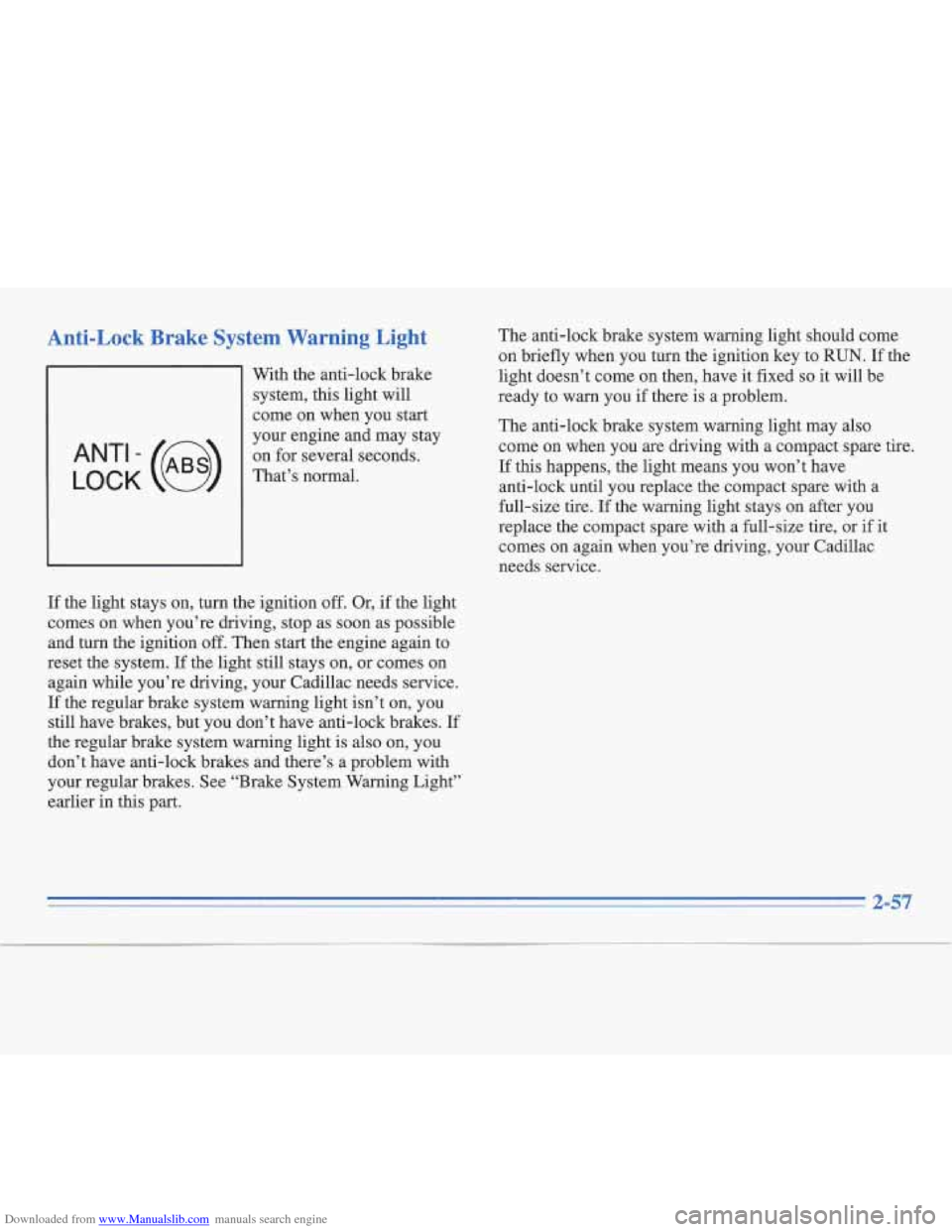
Downloaded from www.Manualslib.com manuals search engine Anti-Lock Brake System Warning Light
With the anti-lock brake
system, this light will
come on when you start
your engine and may stay
LOCK ANT‘- (e) That’s on for several normal. seconds.
If the light stays on,
turn the ignition off. Or, if the light
comes on when you’re driving, stop as soon as possible
and
turn the ignition off. Then start the engine again to
reset the system.
If the light still stays on, or comes on
again while you’re driving, your Cadillac needs service.
If the regular brake system warning light isn’t on, you
still have brakes, but you don’t have anti-lock brakes. If
the regular brake system warning light
is also on, you
don’t have anti-lock brakes and there’s a problem with
your regular brakes. See “Brake System Warning Light”
earlier in this part. The
anti-lock brake system warning light should come
on briefly when you turn the ignition key to
RUN. If the
light doesn’t come on then, have
it fixed so it will be
ready to warn you
if there is a problem.
The anti-lock brake system warning light may also
come on when you are driving with a compact spare tire.
If this happens, the light means you won’t have
anti-lock until you replace the compact spare with a
full-size tire. If the warning light stays on after you
replace the compact spare with a full-size tire, or if it
comes on again when you’re driving, your Cadillac
needs service.
2-57
Page 117 of 306
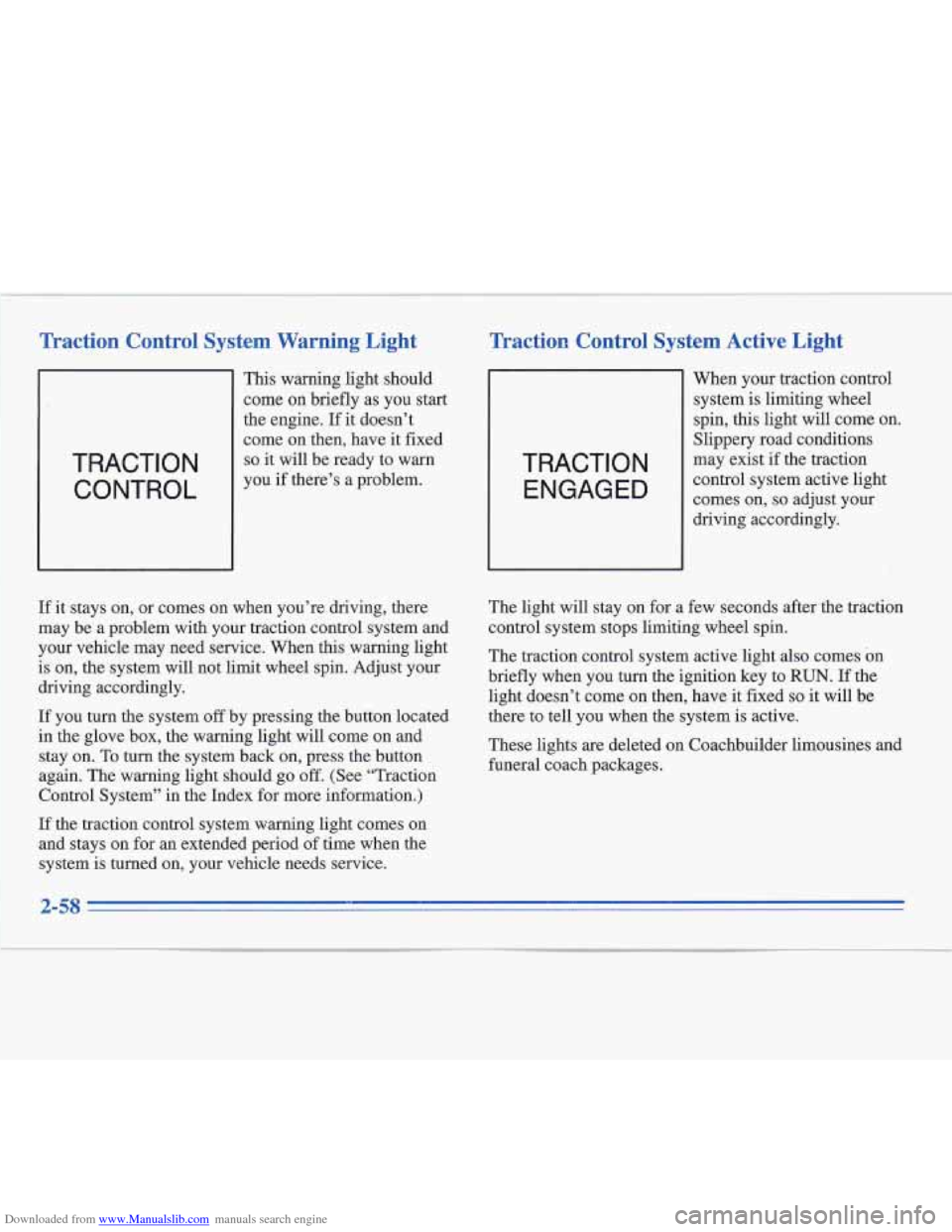
Downloaded from www.Manualslib.com manuals search engine w
Traction Control System Warning Light
TRACTION CONTROL
This warning light should
come on briefly as you start
the engine. If it doesn’t
come on then, have it fixed
so it will be ready to warn
you if there’s a problem.
If it stays on, or comes on when you’re driving, there
may be a problem with your traction control system and
your vehicle may need service. When
this warning light
is on,
the system will not limit wheel spin. Adjust your
driving accordingly.
If you turn the system
off by pressing the button located
in the glove
box, the warning light will come on and
stay on.
To turn the system back on, press the button
again. The warning light should go
off. (See “Traction
Control System” in the Index for more information.)
If the traction control system warning light comes on
and stays on for an extended period of time when the
system is turned on, your vehicle needs service.
Traction Control System Active Light
TRACTION
ENGAGED
When your traction control
system
is limiting wheel
spin, this light will come on.
Slippery road conditions
may exist
if the traction
control system active light
comes on,
so adjust your
driving accordingly.
The light will stay on for a few seconds after the traction
control system stops limiting wheel spin.
The traction control system active light also comes on
briefly when you turn the ignition key to
RUN. If the
light doesn’t come on then, have it fixed so it will be
there to tell you when the system is active.
These lights are deleted on Coachbuilder limousines and
funeral coach packages.
2-58
Page 120 of 306
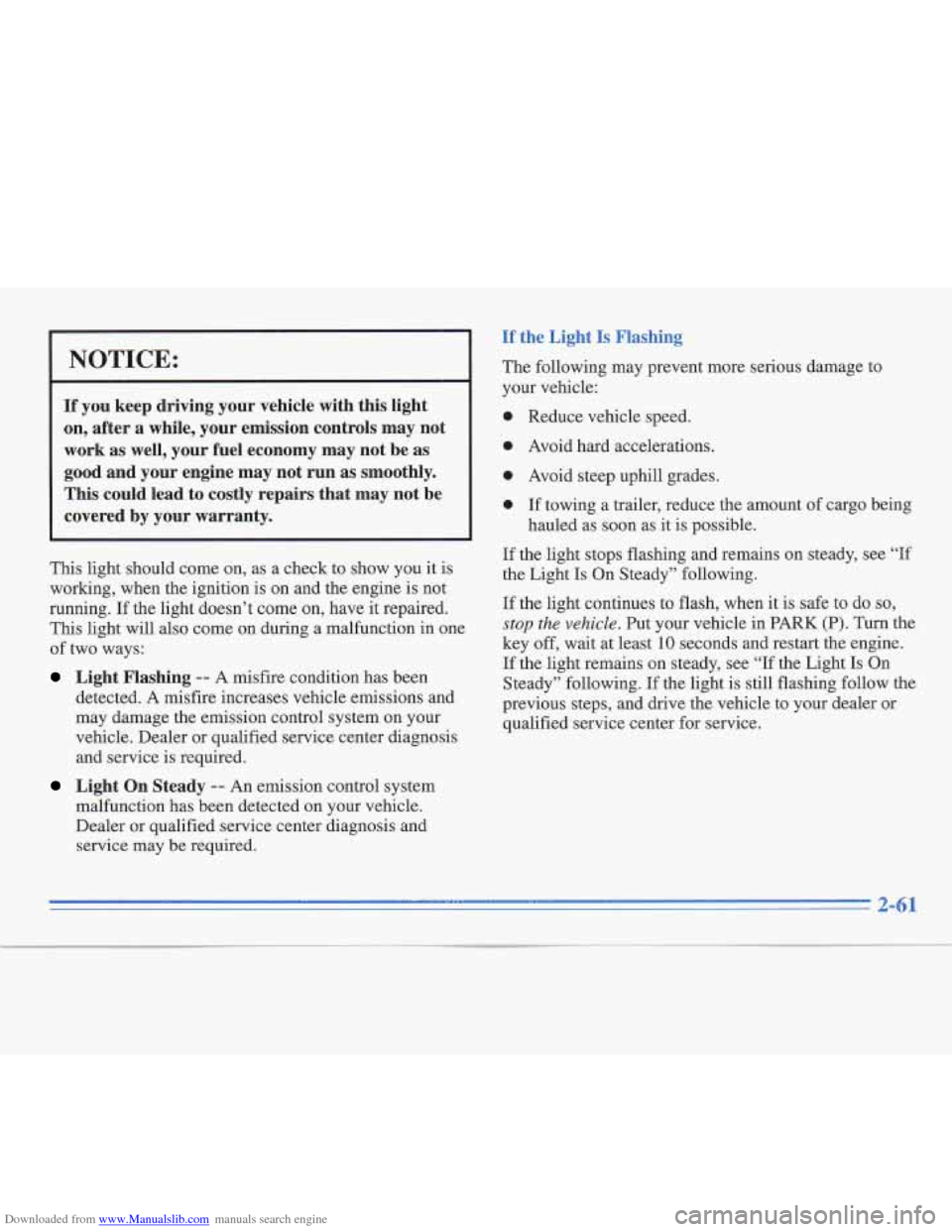
Downloaded from www.Manualslib.com manuals search engine NOTICE:
If you keep driving your vehicre with this light
on, after a while, your emission controls may not
work as well, your fuel economy may not be as
good and your engine may not run as smoothly.
This could lead to costly repairs that may not be
covered by your warranty.
This light should come on, as a check to show you it is
working, when the ignition is on and the engine is not
running.
If the light doesn’t come on, have it repaired.
This light will also come on during a malfunction in one
of two ways:
Light Flashing -- A misfire condition has been
detected. A misfire increases vehicle emissions and
may damage the emission control system on your
vehicle. Dealer or qualified service center diagnosis and service is required.
Light On Steady -- An emission control system
malfunction has been detected on your vehicle.
Dealer or qualified service center diagnosis and
service may
be required. The following
may prevent more serious damage to
your vehicle:
0 Reduce vehicle speed.
0 Avoid hard accelerations.
0 Avoid steep uphill grades.
0 If towing a trailer, reduce the amount of cargo being
hauled as soon as it is possible.
If the light stops flashing and remains on steady, see “If
the Light Is On Steady” following.
If the light continues to flash, when it is safe to do so,
stop the vehicle. Put your vehicle in PARK (P). Turn the
key
off, wait at least 10 seconds and restart the engine.
If the light remains on steady, see
“If the Light Is On
Steady” following.
If the light is still flashing follow the
previous steps, and drive the vehicle to your dealer or
qualified service center for service.
Page 124 of 306
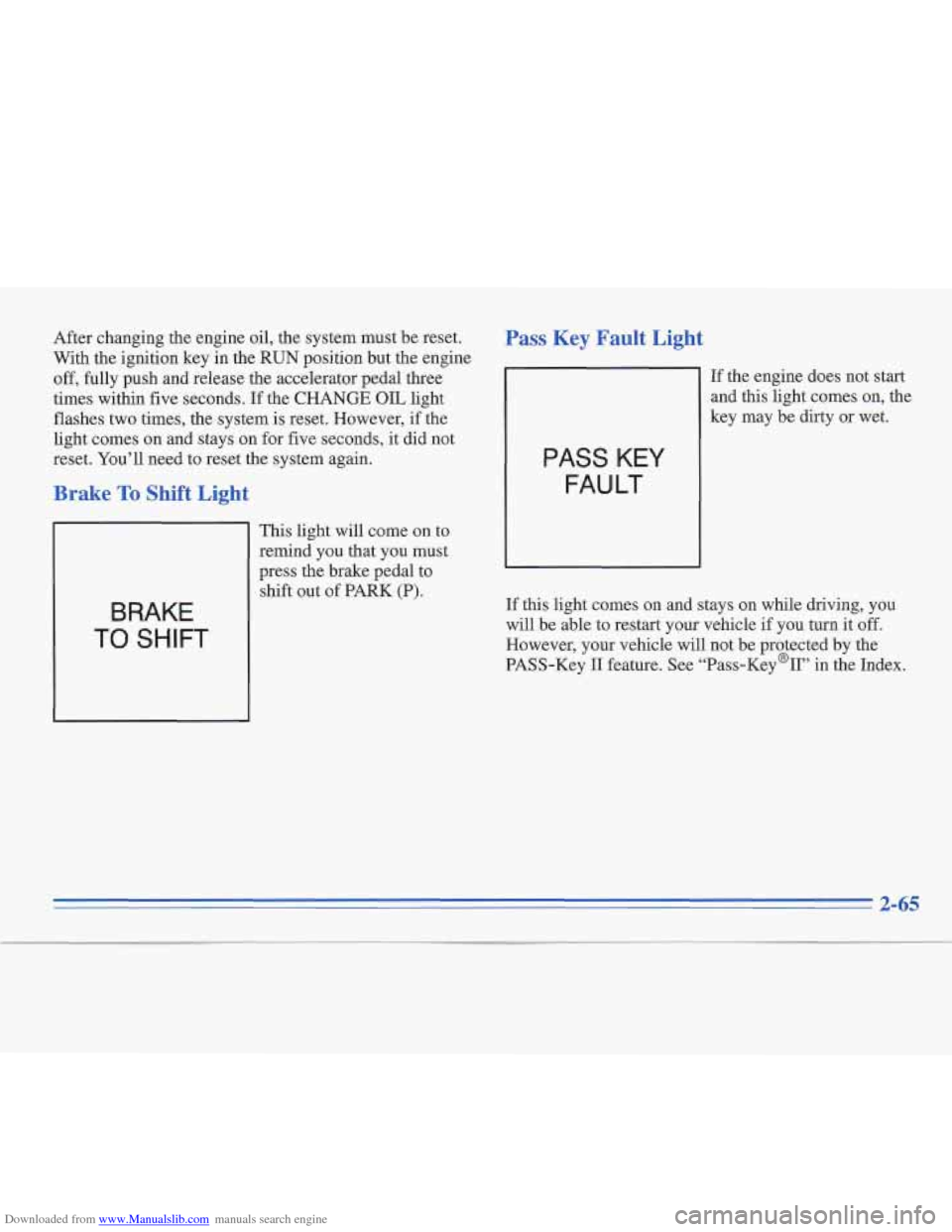
Downloaded from www.Manualslib.com manuals search engine After changing the engine oil, the system must be reset.
With the ignition key in the
RUN position but the engine
off, fully push and release the accelerator pedal three
times within five seconds. If the
CHANGE OIL light
flashes two times, the system is reset. However,
if the
light comes on and stays on for five seconds, it did not
reset. You’ll need to reset the system again.
Brake To Shift Light
BRAKE
TO SHIFT
This light will come on to
remind you that you must
press the brake pedal to
shift out
of PARK (P).
Pass Key Fault Light
PASS KEY
FAULT
If the engine does not start
and this light comes on, the
key may be dirty or wet.
If this light comes
on and stays on while driving, you
will be able to restart your vehicle
if you hrrn it off.
However, your vehicle will not be protected by the
PASS-Key
I1 feature. See “Pass-Key%’’ in the Index.
Page 147 of 306

Downloaded from www.Manualslib.com manuals search engine Drunken Driving
Death and injury associated with drinking and driving
is a national tragedy.
It’s the number one contributor to
the highway death toll, claiming thousands
of victims
every year.
Alcohol affects four things that anyone needs to drive
a vehicle:
Judgment
Muscular Coordination
0 Vision
0 Attentiveness.
Police records show that almost half of all motor
vehicle-related deaths involve alcohol. In most cases,
these deaths are the result of someone who was drinking
and driving. In recent years, some
18,000 annual motor
vehicle-related deaths have been associated with the use
of alcohol, with more than
300,000 people injured.
Many adults
-- by some estimates, nearly half the
adult population
-- choose never to drink alcohol, so
they never drive after drinking. For persons under 21,
it’s against the law in every
U.S. state to drink alcohol.
There are good medical, psychological and
developmental reasons for these laws. The
obvious way to solve this highway safety problem
is for people never to drink alcohol and then drive. But
what if people do? How much is “too much” if the
driver plans to drive? It’s a lot less than many might
think. Although
it depends on each person and situation,
here is some general information on the problem.
The Blood Alcohol Concentration (BAC) of someone
who is drinking depends upon four things:
0 The amount of alcohol consumed
0 The drinker’s body weight
0 The amount of food that is consumed before and
during drinking
0 The length of time it has taken the drinker to
consume the alcohol.
According to the American Medical Association,
a
180-lb. (82 kg) person who drinks three 12-ounce
(355 ml) bottles of beer in an hour will end up with a
BAC of about
0.06 percent. The person would reach the
same BAC by drinking three 4-ounce (120 ml) glasses
of wine or three mixed drinks if each had 1-1/2 ounces
(45 ml)
of a liquor like whiskey, gin or vodka.
4-2
Page 186 of 306
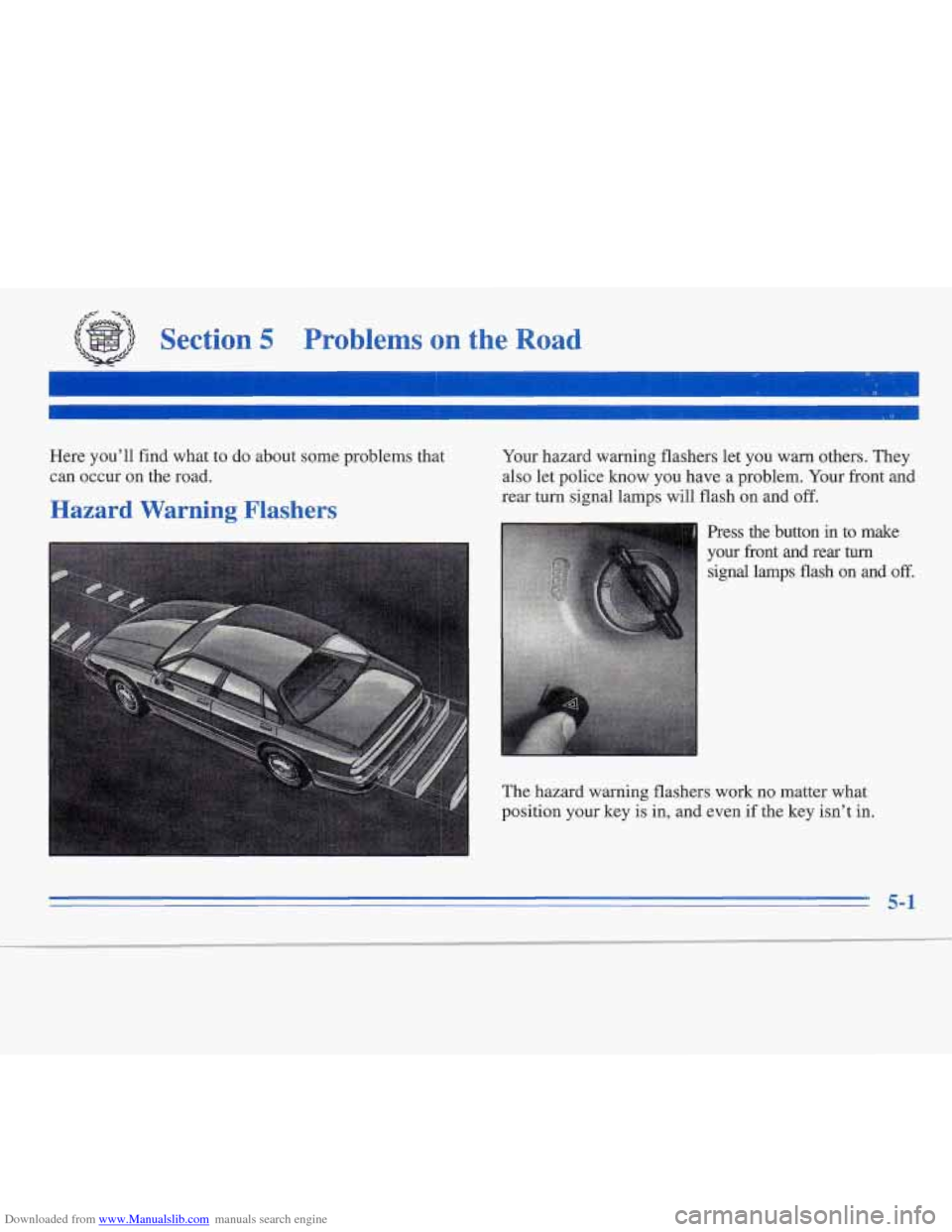
Downloaded from www.Manualslib.com manuals search engine E- -=x
Section 5 Problems on the Road
Here you’ll find what to do about some problems that
can occur on the road.
Hazard Warning Flashers
Your hazard warning flashers let you warn others. They
also let police
know you have a problem. Your front and
rear turn signal lamps will flash on and off.
Press the button in
to make
your front
and rear turn
signal lamps flash on and off.
The hazard warning flashers work no matter what
position your key is in, and even if the
key isn’t in.
5-1
Page 193 of 306
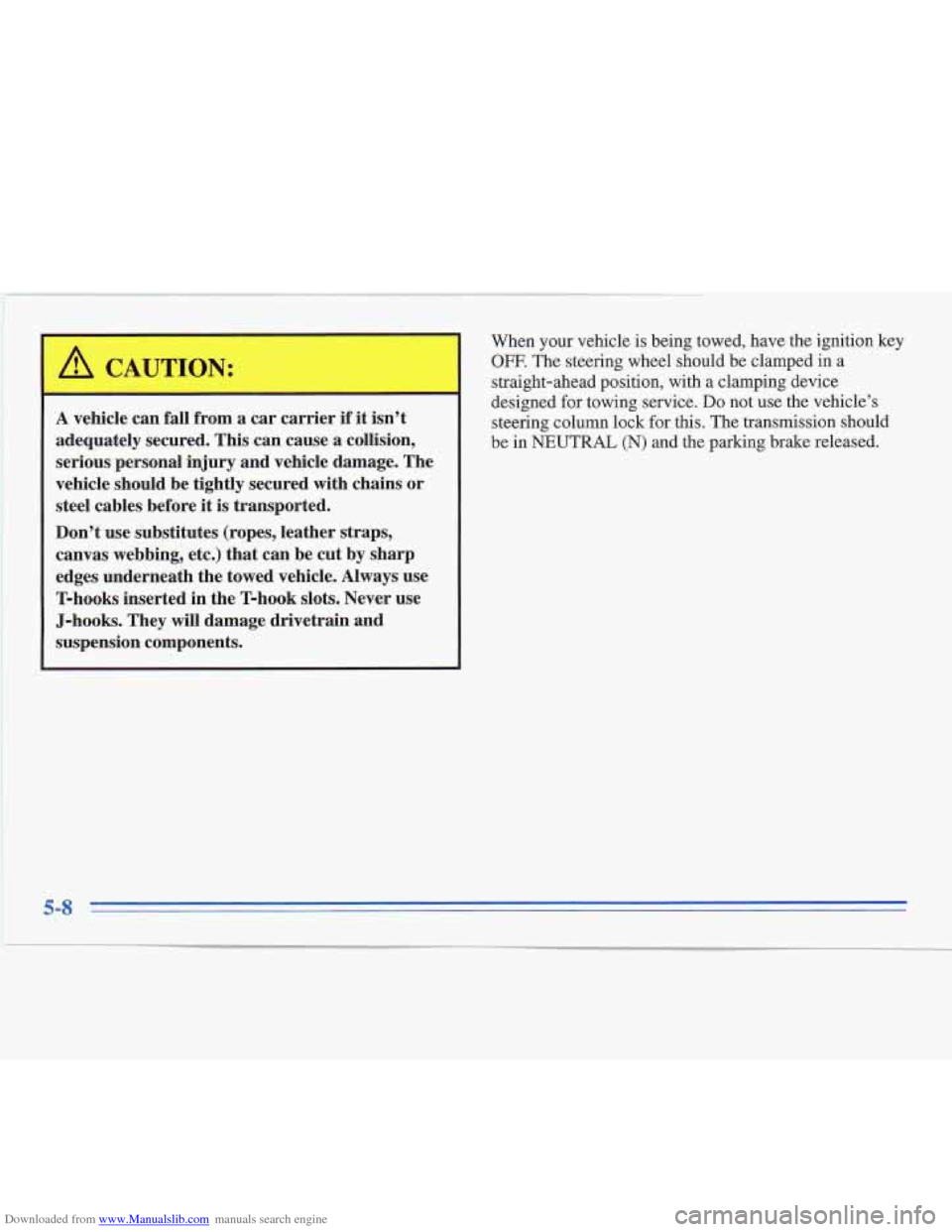
Downloaded from www.Manualslib.com manuals search engine A CAUTION:
A vehicle can fall from a car carrier if it isn’t
adequately secured. This can cause a collision,
serious personal injury and vehicle damage. The
vehicle should be tightly secured with chains
or
steel cables before it is transported.
Don’t use substitutes (ropes, leather straps,
canvas webbing, etc.) that can be cut
by sharp
edges underneath the towed vehicle. Always use
T-hooks inserted in the T-hook slots. Never use
J-hooks. They will damage drivetrain and
suspension components.
When your vehicle is being towed, have the ignition key
OFF. The steering wheel should be clamped in a
straight-ahead position, with a clamping device
designed
for towing service. Do not use the vehicle’s
steering column
lock for,this. The transmission should
be in
NEUTRAL (N) and the parking brake released.